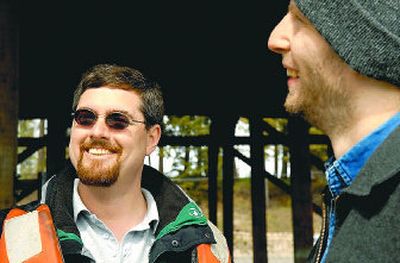Mini subs show major promise

Call it a bloodless coup.
With their lieutenant down, four surviving members of the squadron stand by, ready to assume command. Each is equipped for the task, but in the end only one is destined to lead. As the second-in-command moves to the front, his troops fall in and the mission resumes.
It’s the kind of routine transition of power that happens each day in war zones the world over, though in this instance the troops are tiny, underwater robots operating on a battlefield spanning several thousand square feet of Lake Pend Oreille.
It was there, last week, at the Navy’s Acoustic Research Detachment in Bayview, that a group of University of Idaho research engineers conducted a successful first test of the autonomous underwater vehicle maneuver.
For them, it was a coup of another kind.
“This is the first time this kind of cooperative behavior has been done before,” said John Canning, the mechanical engineer who leads a three-man UI team now in the final phase of testing the capability of the AUV.
If successful, the research soon could be incorporated into existing robot subs assigned the dangerous task of hunting underwater mines for the Navy.
“The Navy is interested in mine hunting, and these (AUVs) can quickly scan a large area for mines,” Canning said.
Although the Navy has been using AUVs for mine hunting and other battlefield intelligence missions for years, UI’s research adds a leap in capability that allows these underwater robots to collaborate among themselves.
One of the key benefits of this cooperative behavior is that any information gathered during a mission is likely to be salvaged, even if some subs are lost.
“The whole point of collaboration is that if only some of the subs survive a mission, they have all the data that all the other subs had collected up to that point,” said engineer Tom Bean, a member of the UI team.
In addition, the subs can give orders and take direction among themselves, even diverting to an “away point” to further investigate a potential mine before returning to the formation.
So far, the Navy has anted up $3.5 million for the effort, which began as a congressional initiative in spring 2004.
Since then, a large team of researchers and graduate and undergraduate students has worked on the project under the direction of Dean Edwards, director of the UI’s Center for Intelligent Systems Research and a pioneer in the field of unmanned vehicle technology.
Edwards said that while the UI research is geared toward mine hunting, the capability his team is developing could have far broader application for military and civilian unmanned vehicles, including surface, land and air drones. The research also has direct implications for creating robots that can learn and think.
“Our cooperative behavior could be used in the languages for other (unmanned vehicles), including surveillance and other missions,” he said.
For now, the UI team, which includes engineers Canning, Bean and Geoff Beidler, is focused on the five miniature subs they tested at last week’s trial.
Made of clear plastic tubes capped by a yellow nose and tail, each sub measures roughly 40 inches long. These “yellow submarines” cost $15,000 each, run on battery packs, and are driven by model airplane propellers, each of which costs less than a dollar.
“It’s not the best for water, but they work,” Bean said.
Once in the water, the subs use transponders and acoustic modems developed by the Woods Hole Oceanographic Institution to provide a compact, low-power underwater communications and navigation system, Canning said. The modem alone makes up about one-third the cost of each sub.
To gather information on their underwater environment, the subs send out ultrasonic sound waves, or pings, to underwater transponders. The transponders then return an acoustic message that allows the subs to triangulate the data among themselves.
Once on the surface, the subs can communicate with their base via wireless Internet, and each sub hosts its own Web site.
“We can check out stats and reconfigure (the subs) through the Web page,” Canning said.
Currently, the subs communicate through something Edwards calls “AUVish,” a machine language comprised of bits and bytes spoken in short broadcasts between the robots and their base.
But the goal, he says, is to translate AUVish into a more “natural language,” similar to basic English.
For some, the idea of talking submarines conjures up dark, sub-aquatic images of freethinking but slightly sinister water-bots floating in a sort of Octopus’ Garden gone tragically mad.
Or, as Edwards describes it in less Orwellian terms:
“The (subs) are using natural languages and communicating back and forth, and it requires a certain amount of logic, so it could evolve into something that is more like thinking robots,” he said. “We’d like to evolve AUVish into more of a natural language.”
In fact, Edwards says, his robot subs have already demonstrated the ability to “learn,” albeit in a very loose sense of the word.
“We do train our robots, and have used simulations to modify things and improve their performance,” he said.
Although natural language can leave room for ambiguities – something engineers generally try to avoid – the ability to analyze robot communications in simple English would make it easier to determine when, where and why missed communications among them may have occurred.
“The natural language is more Orwellian … and there are some disadvantages to it – everything has to be exactly correct,” Edwards said. “But this is the first time they’re moving toward communicating with natural language, and we’d like to take advantage of that.”